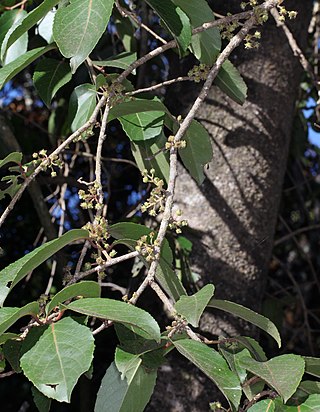
Castanea crenata, the Japanese chestnut or Korean chestnut, is a species of chestnut native to Japan and Korea. Castanea crenata exhibits resistance to Phytophthora cinnamomi, the fungal pathogen that causes ink disease in several Castanea species. The mechanism of resistance of Castanea crenata to Phytophthora cinnamomi may derive from its expression of the Cast_Gnk2-like gene.

Fagus crenata, known as the Siebold's beech, Japanese beech, or buna, is a deciduous tree of the beech genus, Fagus, of the family Fagaceae.
Stevia crenata is a species of flowering plant in the family Asteraceae. It is found only in Ecuador. Its natural habitat is subtropical or tropical moist montane forests. It is threatened by habitat loss.

The long-footed shrew is a species of mammal in the family Soricidae. It is found in Cameroon, Central African Republic, Republic of the Congo, Democratic Republic of the Congo, Equatorial Guinea, and Gabon. Its natural habitat is subtropical or tropical moist lowland forests.
Eugenia brevistyla is a species of plant in the family Myrtaceae. It is endemic to Brazil. Under its synonym Calycorectes australis, it was regarded as endangered, being threatened by habitat loss.
Eugenia discifera is a species of plant in the family Myrtaceae. It is endemic to India. It is threatened by habitat loss.
Eugenia erythrophylla is a species of plant in the family Myrtaceae. It is endemic to South Africa. It is threatened by habitat loss.

Eugenia floccosa is a species of plant in the family Myrtaceae. It is endemic to India. It is threatened by habitat loss.
Eugenia laurae is a species of plant in the family Myrtaceae. It is endemic to Jamaica. It is threatened by habitat loss.
Eugenia rottleriana is a species of plant in the family Myrtaceae. It is endemic to India.
Eugenia umtamvunensis is a species of plant in the family Myrtaceae. It is endemic to South Africa. It is threatened by habitat loss.
Eugenia verdoorniae is a species of plant in the family Myrtaceae. It is endemic to South Africa. It is threatened by habitat loss.
Rinorea crenata is a species of plant in the Violaceae family. It is found in Costa Rica and Panama.

Xylosma crenata, the sawtooth logwood, is a species of flowering plant in the family Salicaceae, that is endemic to the island of Kauaʻi in Hawaii. It is a tree, reaching a height of 46 ft (14 m). Sawtooth logwood inhabits montane mesic forests dominated by koa and ʻōhiʻa lehua at elevations of 975–1,065 m (3,199–3,494 ft). It is threatened by habitat loss.
Conturbatia is a genus of air-breathing land snail in the family Streptaxidae. It is monotypic, being represented by the single species Conturbatia crenata in the family Streptaxidae. It is a species of air-breathing land snail, a terrestrial pulmonate gastropod mollusk.
Eugenia excisa is a species of plant in the family Myrtaceae. It is endemic to eastern Cuba.

Deutzia crenata is a species of flowering shrub in the hydrangea family (Hydrangeaceae). It is native to Japan, where it is common and found throughout the country. Its natural habitat is in forest edges and cliffs. It has been commonly cultivated outside its native range, and has naturalized from plantings in China and North America.

Lacunaria crenata is a species of flowering plant in the family Ochnaceae, native from Central America to Brazil. It was first described by Edmond Tulasne in 1849 as Quiina crenata.







